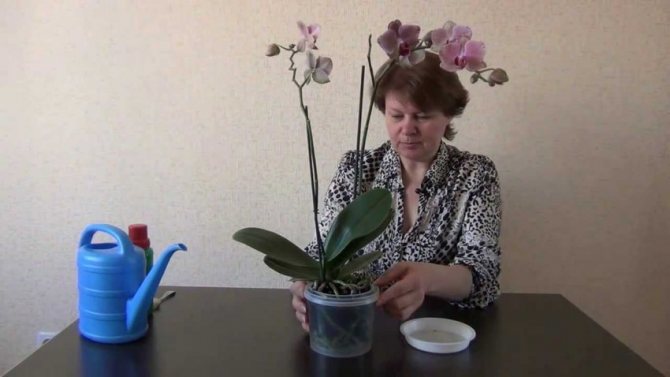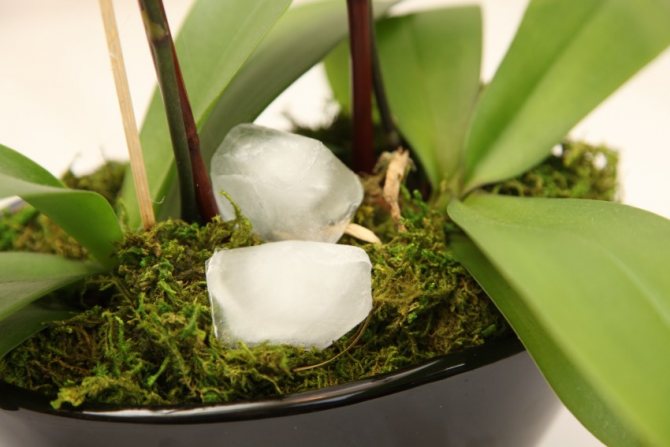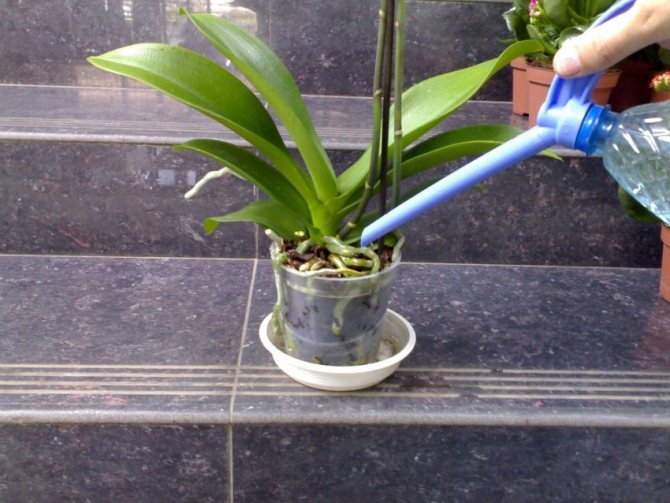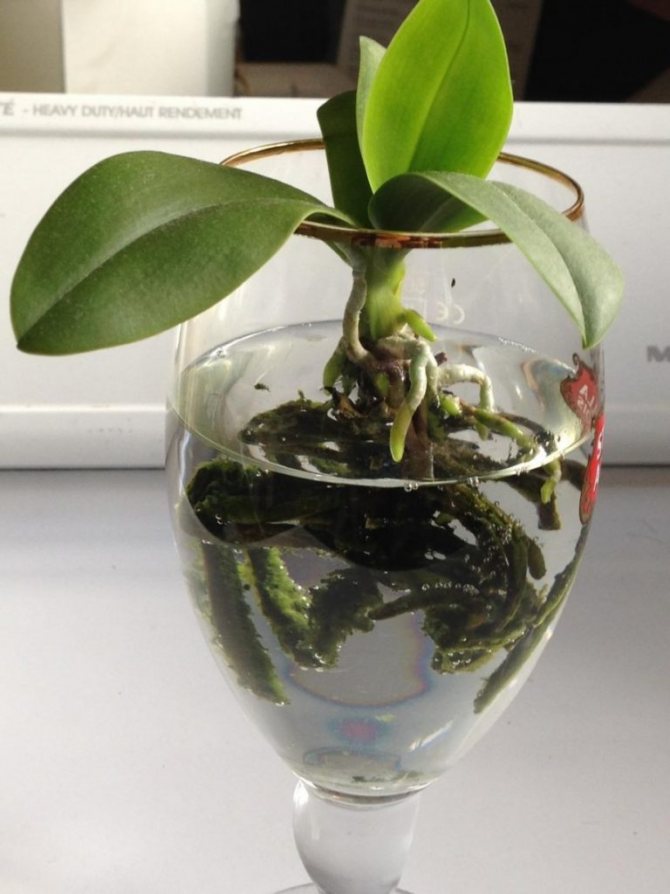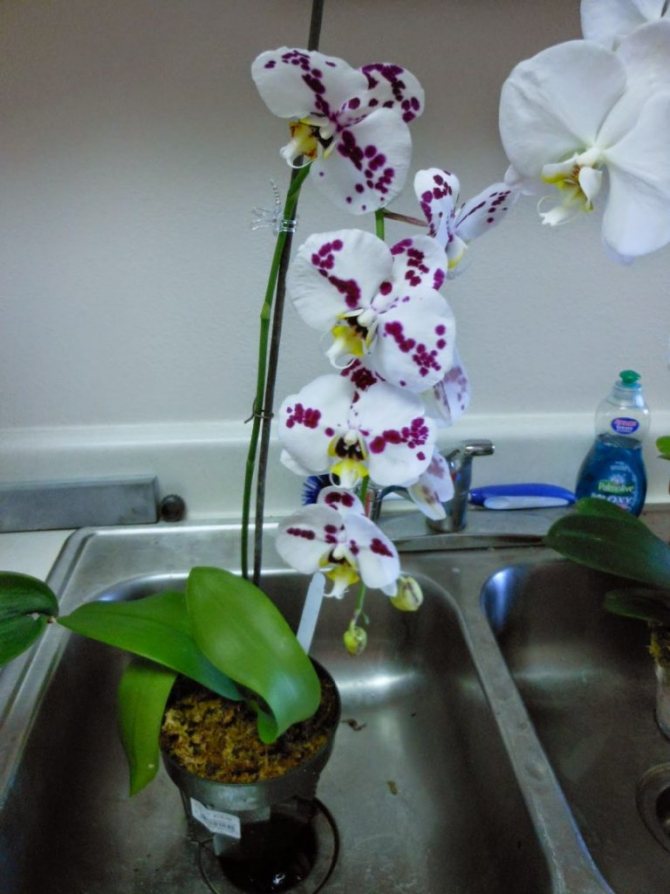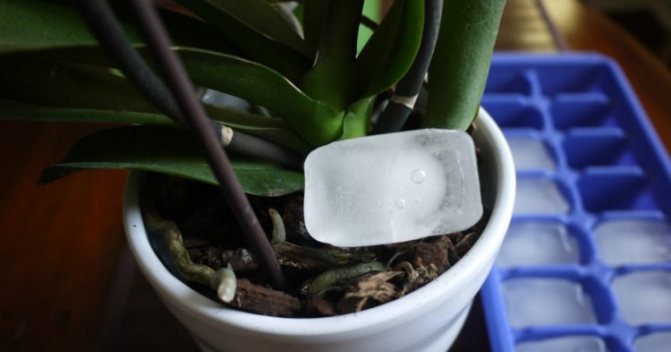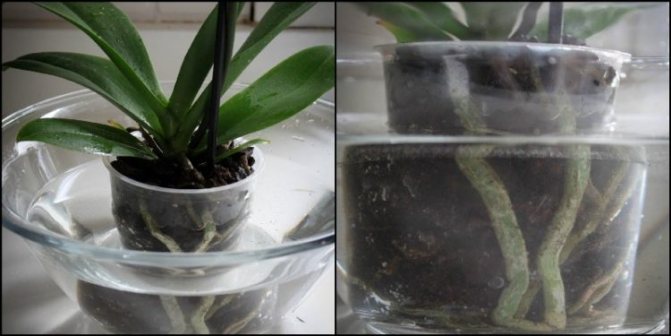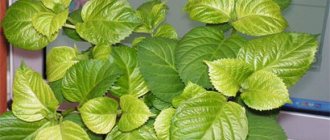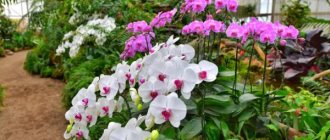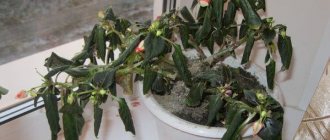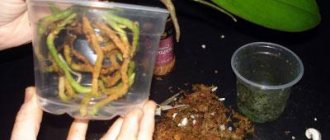An orchid is a beautiful indoor flower. There are about 100 varieties of this plant. Phalaenopsis is considered the most popular species. Because of the shape of the petals, it is called a "butterfly".
The popularity of these flowers is due to the fact that they feel great at room temperature (15-30 degrees). These conditions are optimal for the normal development of the flower.
Phalaenopsis is a genus of epiphytic herbaceous plants of the Orchid family
The plant is unpretentious, but requires regular maintenance. He needs additional feeding, enough light. From the article you will learn how to properly water an orchid at home. With a moisture deficit, the flower dries up, and with abundant watering it can rot.
Today we'll talk about some secrets that will help a flower multiply and bloom in a timely manner.
Basic rules for watering
Water the flower when the potted substrate begins to dry out. The intensity of watering will depend on many nuances: room temperature, humidity, sunlight, period of life, and much more.
Since in the natural environment the orchid is fed by rains, it is advisable for flower growers to use water, which in composition will be close to rainwater. Water should be at room temperature, never hard... Tap water almost always needs to be softened. For these purposes, you can use a special oxalic acid, which is sold in every flower shop and is used to soften the water. A day before the intended watering, you need to make a solution (for 5 liters of water, 1/8 tsp of oxalic acid will be needed). Immediately before watering, the water is drained from the sediment, and then filtered off.
Tropical flowers watered in the morningso that the water evaporates from the leaf axils in a day. Irrigation water must be saturated with oxygen. To do this, immediately before watering, it should be poured several times from one container to another.
Water quality
To water orchids, you can use regular tap water. It should first be defended in order to eliminate harmful impurities, salts are heavy, which not only are not beneficial, but can also damage the flower. It is allowed to use only soft water. If hard water is running from the mains, do not use it.


Only soft water is suitable for orchids
On a note! It is allowed to use not only water from the water supply, but also settled rainwater, distilled. It is advisable to boil the liquid in advance or clear it by passing it through a filter.
Rainwater
If you decide to accumulate rainwater for watering orchids, you must adhere to these rules.
- Collect liquid outside the city so that the plantings are not exposed to the negative effects of dust, which is found in large quantities in urban environments.
- After collecting rainwater, store it in a cool place. This can reduce the rate of bacterial growth.
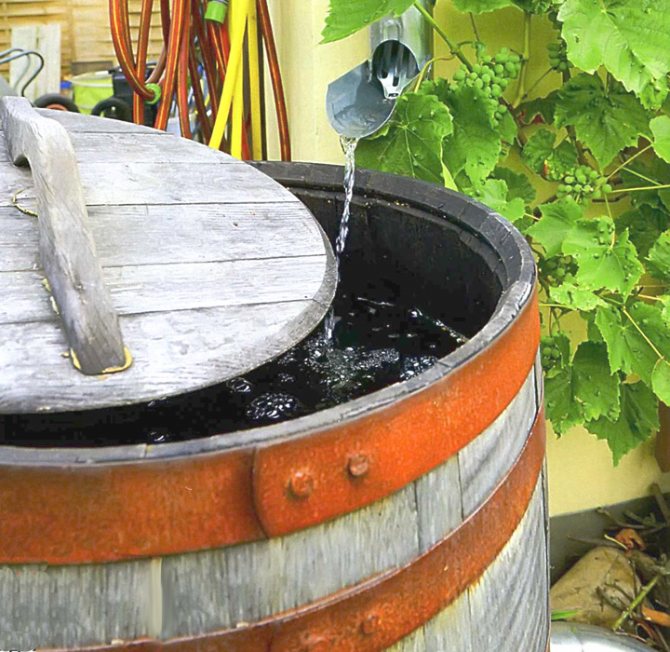

Rainwater harvesting
Rainwater is most suitable for watering orchids.It is not always possible to take advantage of it, since rainwater in the city can do more harm than good. In order not to damage the flower, it is necessary to store the water in proper conditions.
Boiled water
If you notice an increased hardness of the water, it must be boiled. This will soften the liquid. No harmful effects of boiled water on plants are noted.
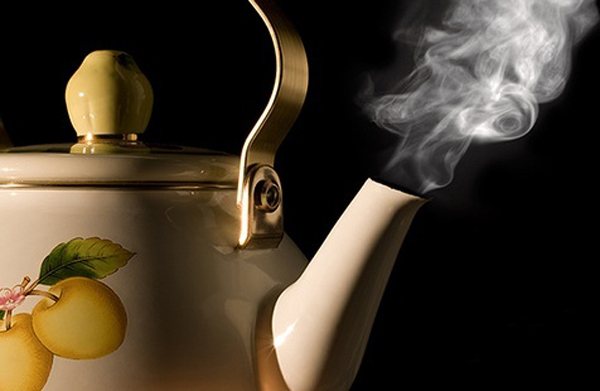

Boil hard water


Water hardness test strips
Distilled water
If you decide to water your orchids with distilled water, you need to dilute it with tap water, focusing on the level of hardness. If the water is very hard, dilute it with tap water in a 1: 2 ratio. If the liquid is of medium hardness, it is enough to mix it in a 1: 1 ratio.
When using distilled water, you can independently determine the desired level of salt content, adjust it by changing the proportions. Among the disadvantages of irrigation with distilled water, the high cost stands out. Cash spending is especially noticeable if the grower breeds orchids in large quantities.


Distilled water
Filtered liquid
If you use special filters to purify running water, you can quickly eliminate heavy metals and dangerous bacteria from the water. Purified water is more suitable for irrigation than regular tap water. In most cases, a lot of money is not spent on water purification. Among the disadvantages of watering with filtered water, a low cleaning speed stands out, especially when caring for a large number of orchids.


Compact device for water purification in an apartment
To accelerate the growth and development of the orchid, it is advisable to pay attention to the acidity of the water. The optimal indicator is pH5. To determine the acidity level, you need to use litmus paper. The orchid benefits from oxygen-enriched moisture. To enrich water, it is enough to pour it from one container to another.
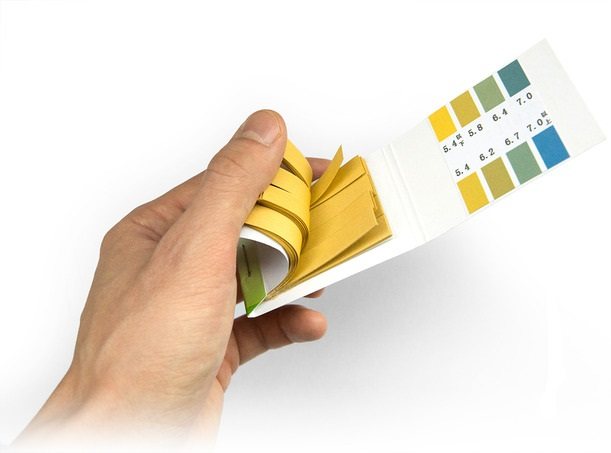

Litmus paper for pH determination


This is a pH meter - a device for determining the acidity (pH) of water
Video - Watering the orchid
How often can orchids be watered
How often to water an orchid at home? There is no specific answer to this question. The frequency of watering depends on the temperature and humidity in the room where the orchid grows, on the type of substrate in the pot, and also on the season. During the rest period after flowering, the plant does not require frequent watering, this fact should also be taken into account when choosing the frequency of watering. The orchid will feel good if you create similar conditions to it in which it grows in the wild.
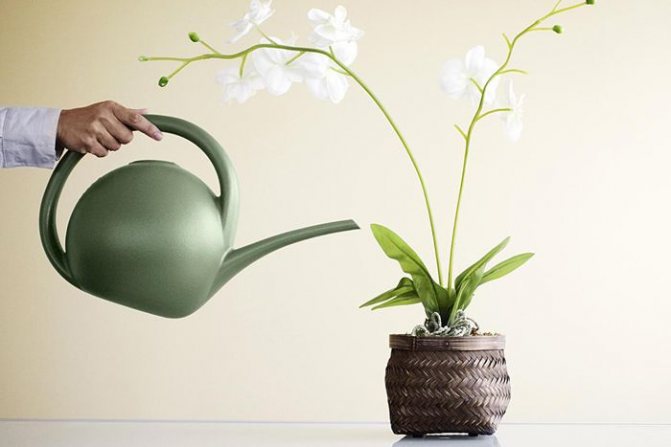

How to determine which watering frequency to choose. Florists advise the following techniques:
- Watering your orchids should be postponed if you notice condensation drops on the sides of the flowerpot.
- Since the root system of orchids is at the surface, the condition of the roots can be used to determine if the plant needs watering. The roots of a bright green color indicate that there is no need to water the flower. If the roots have become light, watering is required.
- You can lift a flower pot and determine by weight whether the orchid needs water. A heavy flower pot indicates that no watering is needed yet. If the pot has become light, be sure to water the orchid.
- Florists use their fingers to check the substrate. If it is dry, the plant is watered.
- You can check the moisture content of the substrate with a toothpick, similar to pie in the oven. Any housewife knows how to check the readiness of the cake: holes are pierced with a toothpick, after which the toothpick is taken out. If it is dry, the pie is ready, if pieces of dough are stuck to it, the pie is set to bake. Pierce the substrate with a toothpick. If the substrate particles have stuck to the wooden stick, it is too early to water the flower.
- If you notice that the soil in which the orchid grows has brightened, this means that the flower needs watering.
The frequency of watering also depends on the type of flower. When purchasing an orchid, ask what kind of watering is needed for this type of plant. As a rule, orchids are watered 1-3 times a week in summer and only a few times a month in winter.
How to water a flower after transplanting into dry soil and pruning roots
After buying a plant in a store, ask about the nuances of transplanting into another soil. The optimal time is spring, when the leaves and the root system are actively developing.
After cutting the root system, the orchid must be transplanted into dry soil. In the summer, we water the plant in a day, and in the winter in a couple of days. At the same time, we compact the soil well with the substrate, and add water to moisten the soil. After that, we adhere to the usual regime.
If almost all the roots of the flower have been cut off, then you need to wait for the full development of the plant, and only after that start moisturizing. During this period, orchids require a sufficient amount of light.
Which water is suitable
Much depends on what kind of water is used to water tropical flowers. In the wild, orchids water the rains, but in our ecology, rainwater can contain a whole range of different chemical constituents, so it is better not to use it for irrigation.
The water you will water the plants with should be soft. There are many ways to determine the degree of water hardness. One of the indicators that hard water is flowing from the tap is that scale builds up very quickly in the kettle.
You can buy special tests to determine the degree of water hardness, which will accurately determine how hard the tap water is. Before watering the flowers, soften the hard water.
Water softening methods
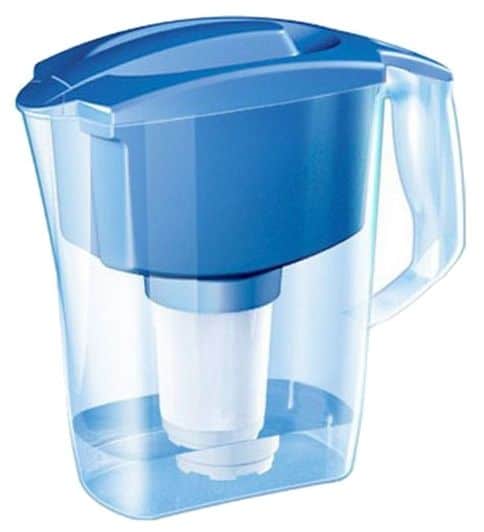

- Oxalic acid, which is diluted in water and left for a day. After that, the water must be carefully drained, being careful not to touch the sediment.
- A canvas bag filled with high-moor peat is left in the water for irrigation. Before watering, the bag is removed from the container. This method will not only soften, but also acidify the water.
- Before watering, water is passed several times through a household filter.
- Quite often, experienced flower growers use boiled water at room temperature for watering flowers. When boiling, all harmful microbes are killed, chlorine is eliminated, and heavy salts precipitate.
- To improve the condition of the water used for irrigation, many add garlic, succinic acid, and potassium permanganate. Garlic water helps to improve the flowering of orchids, and at the same time decontaminates the plant. Amber water increases the immunity of the plant, contributing to the better resistance of the orchid to various diseases. A weak solution of potassium permanganate helps disinfect the roots.
Novice growers make the mistake of using distilled water for irrigation. It is absolutely impossible to water the orchid with purified water! Distilled water is used for flushing leaves, roots, irrigation, and for breeding dressings.
The water temperature for irrigation should vary between 30-40 degrees. It is also important what the acidity of the water will be. A ph-level of 5.5 is ideal. Check acidity with litmus paper. If the acidity level of the water is lower, add a few drops of freshly squeezed lemon juice.
Is it possible to water Phalaenopsis with potassium permanganate
To destroy bacteria, pests and fungi, flower growers use a weak solution of potassium permanganate. This method should not be abused. We alternate with regular watering.
We dilute potassium permanganate in water and pour the substrate with a solution. This method is used 1-2 times a year to prevent diseases.Increased acidity can simply burn the root system. Therefore, the mixture is used only in extreme cases.
Watering methods
Depending on what kind of orchid you grow, watering can be of several types:
Hot shower
Watering that is as close to tropical rain as possible will help your orchid stay healthy, grow faster, and bloom more often. A constant shower is a prophylaxis against pests and bacteria. How to arrange an orchid shower:
- The orchid pot should be placed in the bath. Using a shower head, apply a low pressure and spray the plant with warm water. The water temperature should be around 45 degrees.
- Once the substrate is completely saturated with water, the orchid should be left in the bathroom for 20-30 minutes to allow all excess moisture to glass.
- After that, using a soft dry napkin or cloth, gently wipe off each leaf and young sprout. If you are giving a shower to the Wande or Phalaenopsis orchid, you should wipe the core dry, otherwise the plant may start to rot.
- Remove the pot from the bathroom and put it in its usual place - if it is a windowsill, you should take care that direct sunlight does not fall on the orchid.
Plants immersion
A fairly popular and effective watering method, but it is used only when the orchid is completely healthy. A pot along with an orchid is lowered into the previously prepared water. Pots measuring about 12X12 cm are left in water for half a minute, after which they are kept in the air so that all excess water has time to drain.
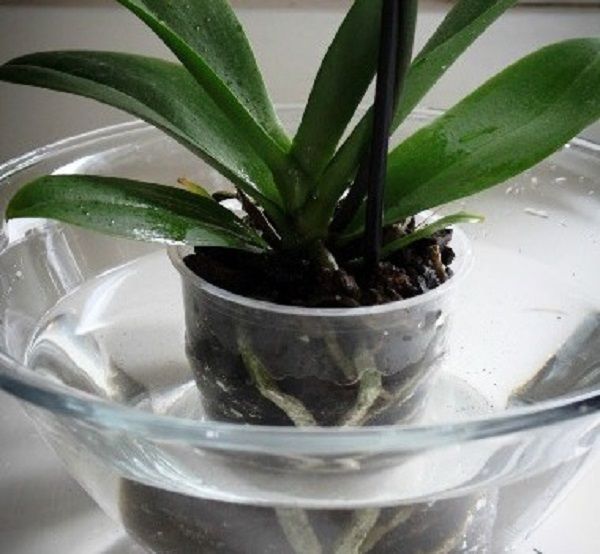

Classic watering
Many growers are accustomed to watering indoor plants with a special watering can. Orchids can also be watered with a watering can using a very low pressure. Water pours until excess moisture begins to drip from the holes below. Wait until unnecessary water flows out of the pot, then repeat the procedure. Make sure that the water remaining in the pan is poured out in time, otherwise you can provoke plant decay.
Irrigation of the root system
When the orchid is grown without a substrate, irrigating the roots is the best way to water it. In a pot with substrate, the roots do not dry as much as when growing orchids using blocks. You will need a special flower spray bottle. Set the "Fog" mode, aim the spray gun directly at the roots. Water until the roots change from earthy to green. A second procedure will be needed when the roots begin to dry out.
Surface watering
In this method, a watering can is used, from which the substrate itself is poured with a thin pressure. The water slowly fills the substrate and then evaporates over several days. Watering is necessary until the substrate is completely wetted with water. In no case should you transfuse an orchid! Surface irrigation is considered the most affordable and simplest method.
Watering in a pallet
Those florists who value their time use the method of watering flowers using a pallet. The process is very simple and quick: the pots with orchids are placed on one large tray, where you need to pour the prepared water. The orchids themselves will take as much water as they need.
Features of moisture consumption by orchids
The mode of moisture consumption is influenced by the lifestyle of plants. To create comfortable conditions for the growth of orchids, it is necessary to adapt the process of home watering to the natural conditions in which the plant receives moisture.
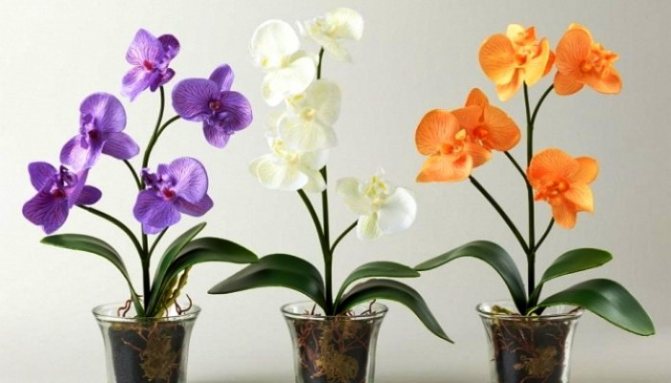

Growing orchids in transparent pots
Here are some important features of the process.
- Orchids receive moisture from rain, dew, fog. The soil dries quickly, so that moisture does not stagnate in the root system.
- Plants consume water in small doses. The special structure of the root is remarkable. Fine hair is covered with a corked fabric, which is similar in structure and effect on moisture absorption to a sponge.
- The ability to survive even long periods of drought. The liquid accumulates in the stem, leaves, and other green areas of the plant.
- Cyclical development. When the roots and stems have reached the required size, it is time for flowering. In their natural habitat, orchids bloom during periods of high rainfall. When growing orchids at home, it is necessary to increase the amount of moisture when the plant is in bloom.
- The rate of moisture absorption depends on the growth rate. When the plant receives little light, the development processes slow down, the orchid goes into a dormant state. At this time, the need for moisture decreases. If you continue to water the plant, moved to the shade, at the usual frequency, you can provoke root decay, the onset of other diseases.
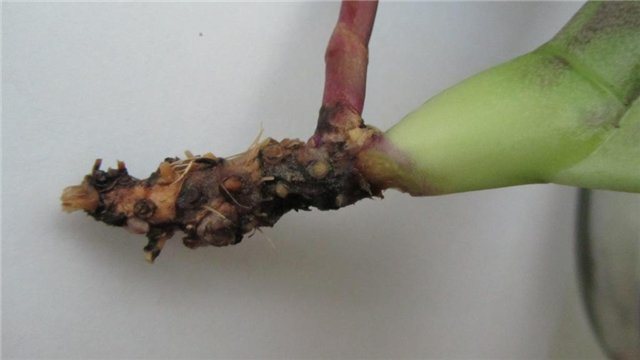

Rotting roots
On a note! To confirm or exclude the plant being in dormancy mode, it is necessary to assess the condition of the roots. If the flower is in the active phase of growth, the root is green, and a growing point can be found on it. When the flower goes dormant, the root turns white.
How orchids are watered when they bloom
How to water orchids that are starting to bloom? As soon as the orchid begins a period of active flowering, watering frequency increases up to several times a week... Watering is ideal 2-3 times every 7 days... The flower is watered early in the morning, in no case allowing the roots to flood. After the appearance of the peduncle, watering becomes more frequent, since the plant needs additional nutrition.
If the orchid blooms in a dry environment, it should be watered more frequently than usual. It is advisable to add irrigation to the leaves, but you should be very careful not to let water get on the flowers and buds themselves.
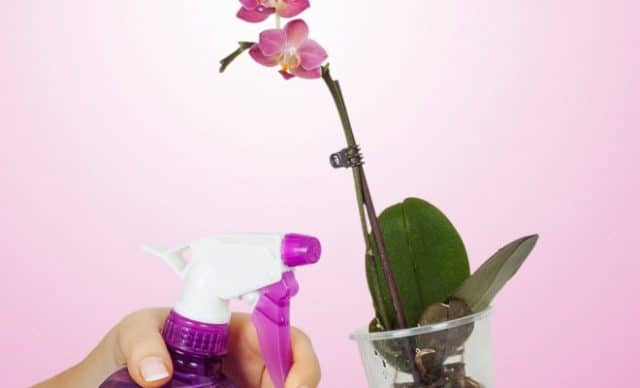

After the end of flowering, when the flowers begin to wilt, watering is halved. It is necessary to monitor the substrate: by the next watering it should be almost dry.
The importance of the procedure
For both people and for plants, water plays a significant role in their existence. In order for the plants to receive all the necessary minerals, the soil must be sufficiently moist and fertilized, while the substrate must dry out from time to time, and not be continuously wet.
There is no regularity in watering orchids, the most important rule in watering is to provide the plant with water 2-3 days after the roots and substrate have dried (read about the frequency of watering phalaenopsis here). It is worth remembering that excessive flooding of the flower with water can lead to rotting of the roots, the emergence of bacterial and fungal diseases.
Much attention should be paid to water quality, because tap water contains a lot of salts that can harm the plant, because water for orchids is not just a source of drinking, it is also food (read about what kind of water you need to water your orchid here).
Attention! Regardless of the method of watering, you should always remember the main rule - it is better not to top up than to overflow.
Most orchids are excellently adapted to short-term and some long-term droughts. Their fleshy leaves and pseudobulbs contain enough moisture to survive dry periods.
Watering orchids in winter
In the last months of autumn, the orchid rests at rest. The flower no longer needs such frequent and abundant watering as in summer, during the flowering period. In winter, orchids are recommended to be watered no more than once every two weeks.
In winter, the root system of orchids does not absorb water so actively, so the immersion method is considered the most suitable. After diving, do not forget to let the excess water drain completely so that the root system does not rot.
It is best to water the flowers in the evening in the autumn-winter period. It is better to water in a warm bath, leaving the orchid in it in order to allow excess water to drain completely.Do not put the flower in a cool room immediately after watering. Sudden changes in temperature do not have the best effect on the condition of orchids.
Hot shower for orchids
A hot shower will help to restore and adapt the plant after transplantation. The procedure is not carried out very often. Once a day is enough. The timing of such watering depends on the recovery period of the orchid.
A warm shower helps to gain strength and remove dust from the leaves. The temperature of the liquid depends on the degree of acidity, which depends on the composition of the substrate and should be in the range of 50-70 degrees.
After water procedures, we leave the pots with the plant in the bathroom so that it stays in high humidity conditions for some time. This procedure will speed up the breeding process.
How to water immediately after purchase
As you know, replanting orchids immediately after purchase is not recommended. The plant after a change of scenery is in shock, and it must be given time to recover, so that it gets used to the new place. This usually takes about two weeks. After transplanting, the orchid immediately needs watering. After the first transplant, experienced flower growers put the flower pot in a large container with warm water, and after 20-25 minutes they take out the pot so that the excess liquid is glass. After that, the orchid is placed in a place where direct sunlight will not fall on it.
There is no need to water the orchid for two weeks after that. Subsequently, the plant is watered according to the standard scheme, at least several times a week. As a rule, by this time the orchid begins to bloom, and then watering is carried out according to the usual rules.
Surface watering of a flower
Not all agronomists agree that the orchid needs to be watered from above. However, such a procedure is mandatory, as it has a beneficial effect on the orchid.
Using a sprayer, water the leaves and the top layer of the substrate. In minimal quantities, the plant can be sprayed daily. But just do not overdo it, as the leaves will turn yellow and wither.
After transplant
Orchids are transplanted not only after acquisition, but also after hibernation. It is worth noting that large pots are best avoided. The more compact the flower pot into which the orchid is transplanted, the better the roots will develop in it. As soon as the flower is transplanted into a new pot with a new substrate, it should be watered immediately. Then the flower pot with the orchid should be placed in a container filled with warm water for 20-25 minutes. After this time, excess liquid should drain, and then the pot is placed in a darkened room, away from bright sunlight. The next two weeks after transplanting, the orchid does not need watering. The flower is stressed after transplanting, so it is better not to disturb it. Frequent watering can only aggravate the situation, so leave the orchid alone for 14 days.
After the orchid adapts to new conditions, it will need additional nutrition, a comfortable place, and good care. You need to water the flower at least twice a week, ideally 2-3 times every 7 days. Orchids are transplanted in the summer, before flowering, so watering should be more frequent.
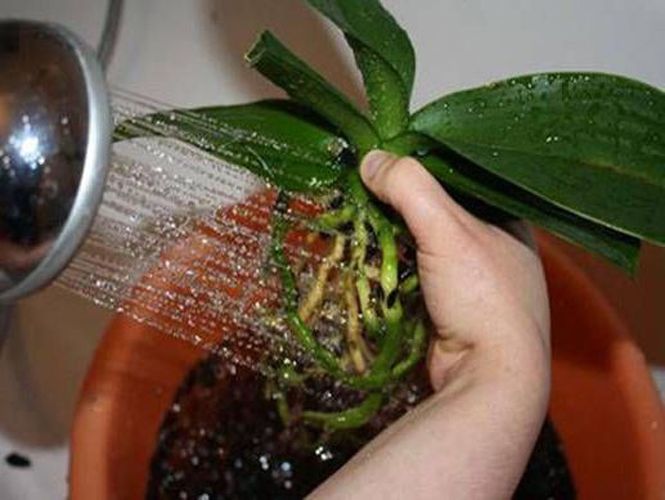

What are the consequences and how to deal with them?
Waterlogging causes the greatest harm to orchids, and it will be much more difficult to restore a flower than with a lack of moisture.
- If a the plant rots the center (growth point) - this may indicate that water has entered it, which can often occur when pouring a shower. This case will no longer respond to treatment.
- Fungusif the lesion is not very large, it can be cured. Enough treatment with fungicides and watering the plant less often.
- Flabby, shriveled, yellowed, dry leaves with black spots appear as a result of drying out or vice versa, waterlogging.In the second case, the leaves do not have enough moisture, because it can no longer enter them through the decayed roots, and it is already pointless to water, because the affected roots cannot supply moisture.
Important! Rotten roots must be cut off as quickly as possible to living tissue, and the cut site must be treated with charcoal or colloidal sulfur.If you had to remove all the roots, you should cover the rosette with potassium humate or Kornevin and transplant the orchid into a new substrate. In the event that rot from the roots has managed to get over to the stem, saving the plant will be an almost impossible task.
- Watery, soft spots on the leaves indicate waterlogging, mainly after too long immersion irrigation. To get rid of the problem, you should correctly apply the immersion method and allow the substrate and roots to dry completely.
- Highly short root tips and white bloom on the substrate talk about poor water quality, and for the next irrigation it will be necessary to use more purified water.
The most important thing to know in order to successfully grow orchids is that their roots are different from those of other houseplants and therefore require a completely different approach to watering. Proper watering will keep these flowers healthy and beautiful for a long time.
We suggest you learn about other nuances of watering an orchid: after transplanting into another pot, in winter and autumn, in a pot at home, the rules for watering at home and during flowering.
What errors can occur
Improper watering can lead to disastrous results, up to the death of the plant. What mistakes are made when watering:
- Excessive moisture can cause root decay. To avoid this, it is necessary to install a foam drain with a height of approximately 4 cm.
- Water during irrigation should in no case get into the axils of the leaves. If this happens, immediately wipe the leaves dry with a soft, clean cloth or napkin.
- Using the spraying method, this should be done at a distance of about 20 cm. Otherwise, large drops form on the leaves and flowers, which negatively affect the appearance and condition of the plant.
- Irrigation water must meet all standards. By using hard, too cold or polluted water, you risk the health and even the life of your orchids.
- Prepare the water thoroughly for irrigation in advance. It should be soft, at a comfortable temperature, with a suitable ph balance.
- Watering the flowers is necessary only in the morning, as watering in the sun can cause burns. The best time for watering is early morning.
- The immersion method is used only when the orchid and substrate are not infected with any disease. Just in case, it is better to change the water after each pot. In the event that the flower is in the incubation period, you will reduce the risk of infection with other orchids.
Watering errors
Florists often make mistakes when watering orchids. It is fraught with emergency transplants, long-term rehabilitation, or even the death of a flower. Below we describe the main ones so that you can avoid them:
- Overflowing. The worst thing for an orchid is excess and stagnant moisture. This must always be remembered.
- Bad water. Gradually, from watering to watering, clogs the pores of the roots. The plant dies gradually, and it is almost impossible to understand the reasons. We need good water.
- Water ingress to the growth point. When watering, you need to make sure that water accumulates between the leaves. This will lead to rotting.
- Watering in the sun. Most indoor orchids cannot stand the sun at all. But even those that are loyal to him cannot be watered and sprayed on a sunny day, otherwise burns are guaranteed.
And in conclusion, we add that in addition to strictly following the watering rules, you just need to be careful. Usually the plant will tell you if you are doing something wrong. You just need to take a closer look.
We offer a video about caring for an orchid:
How to water a dwarf orchid
Dwarf orchids have recently become very popular. A small plant with beautiful flowers attracts many growers, but dwarf orchids require proper care. The health of the mini-orchid and its flowering depend on how correct the watering will be.
How to properly water an orchid? During the dormant period after flowering (this period takes place in the winter months), the mini-orchid should be watered no more than once every two weeks. In the warm season, when active flowering of all orchids begins, dwarf flowers should be watered once every 3-4 days.
The substrate or moss in the pot does not need to be moistened until the moisture has completely evaporated from it. Mini-orchids, thanks to dry roots, receive the necessary oxygen, so they should not be poured with water under any circumstances. The little Phalaenopsis orchid loves watering by immersion in water. A pot with a mini-orchid is immersed in warm water and lasts about 20-25 minutes. For a long time, dwarf orchids should not be left in water, otherwise rotting may begin in the root system.
Using garlic water
Garlic is good for Phalaenopsis. To prepare top dressing, you need to insist it in water for a while. As a result, the liquid is enriched with vitamins and nutrients.
Benefits of garlic extract:
- Prevention of fungal and viral diseases;
- Destruction of pests;
- Strengthening the immune system;
- Disinfection of soil.
Watering with garlic water should be alternated with regular liquid, otherwise the plant may die.
Use this method when the orchid has stopped blooming. And in a couple of weeks, new buds will appear.
For nutritious irrigation, peel the head of garlic, and fill it with 1 liter of boiling water. After 20 minutes, dilute the solution in water in a ratio of 3 tablespoons to 1 liter of water.
Flowers cannot be watered with such water, otherwise they will soon fall off.
Is it possible to reanimate a dried orchid
With improper watering, the orchid begins to dry, the leaves become yellow and lethargic, the flowering process does not begin. As soon as you notice the first symptoms, the orchid should be treated immediately. The sooner this is done, the higher the likelihood of a favorable outcome.
You should immediately check the condition of the root system of the orchid. Perhaps the roots are too dry or, on the contrary, have begun to rot. During the flower recovery period, it is better to use the method of spraying or dipping the orchid in a pan of warm water.
If the orchid is watered too often, you can get the opposite effect: the flower begins to rot, fungal diseases may appear. To prevent these problems, it is necessary to moisten the substrate only after it is completely dry. If you water the flowers without waiting for the substrate to dry, you can bring the orchid to illness or even death.
The size of the flower pot in which the orchid grows is of great importance. The flower feels much better in a tighter pot, moreover, in large flowerpots, the substrate dries much longer.
Caring for orchids is not so difficult, but a lot will depend on proper watering. You should study the basic rules for watering and feeding tropical flowers in advance, so as not to face serious problems in the future. If properly watered and cared for, orchids will feel great and will delight their owners with excellent, gorgeous, incomparable flowering.
How to use succinic acid correctly
You don't have to buy expensive fertilizers to care for your orchid. At home, you can make simple remedies. One of the available drugs is succinic acid. It helps to improve flower growth, increase the number of buds, and allows you to recover from illness.
We dilute one tablet of the drug in 1 liter of warm water. First, we dilute it in 200 ml of water, after which we pour in 800 ml of liquid. If you bought acid in powder, but add 1 g per liter (at the tip of a knife).
We use a watering can for watering. And spread it in a thin stream over the entire surface of the soil. When liquid begins to flow out through the drainage holes, the procedure should be stopped to drain excess water.
To prevent the development of diseases, we wipe the leaves of the plant with the resulting solution. It is also recommended to wet the roots of the flower to stimulate growth.
What water to water an orchid at home
Now a large number of phalaenopsis orchids are being sold; many buy these unpretentious beautiful flowers as a gift or to decorate the house. In order to phalaenopsis orchid long years of color at home you need to know the features of caring for this flower, and the main factor in the development and flowering of any plant is correct watering.
Water is the basis of the life of all plants, proper watering of indoor flowers at home should be individual for each type of plant, as needed. Phalaenopsis orchid is a tropical plant and many people think that this flower requires a lot of moisture, this is the main mistake of novice growers. Phalaenopsis tolerates short-term overdrying better than a constantly moist, non-drying substrate, in which the thick filamentous roots of the orchid quickly rot and die off.
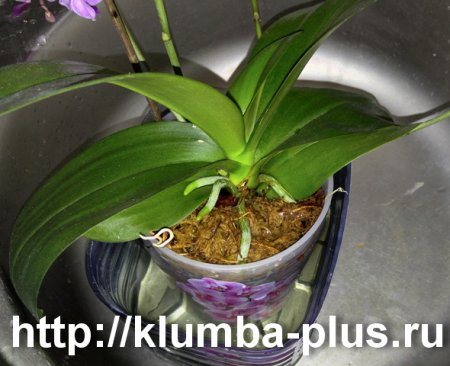

Phalaenopsis orchid- the plant is an epiphyte, in tropical forests it grows on trees, in the forks of branches, on snags and stumps, therefore the thick cord-like roots of the plant are in moss, plant debris or hang freely in the air, they are constantly blown through, and moisture and nutrients are obtained after periodic rains and from a constantly humid atmosphere. In ordinary soil, the roots of an orchid are not adapted to develop, they quickly rot, not receiving enough air, since after watering they do not dry out for a long time. For the phalaenopsis orchid, a special substrate is needed for planting, consisting of pieces of pine bark 1-2 cm in size, pieces of a tree corner and sphagnum moss.
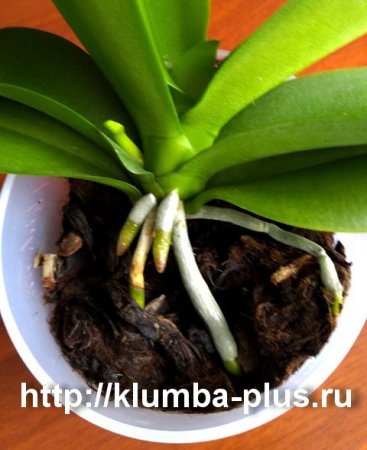

Healthy phalaenopsis orchid roots light green, covered with a silvery bloom, in them, as in the leaves, the process of photosynthesis takes place in the light, those roots that do not receive illumination are painted in white or light yellow light. When waterlogged, the roots of the orchid are affected by putrefactive bacteria, brown spots appear on them, which grow into large brown areas, the consequence of the dying off and drying out of the whole branch of the roots. Orchid roots affected by rot cannot provide the plant with moisture and nutrients, the orchid stops developing and may die. Prevention of orchid root decay is to dry the substrate between waterings.
Prolonged overdrying of the substrate leads to a weakening of the plant. With a lack of moisture, orchid buds can turn yellow and fall off without opening into flowers, signs of drying out appear on the lower leaves, veins begin to stand out sharply.
When should you water your orchid?
The appearance of the roots and substrate will tell you about this. Phalaenopsis orchids are recommended to be grown in transparent plastic pots in order for the roots to participate in the process of photosynthesis, even through such pots it is easy to monitor the state of the root system of the plant, the substrate and determine when it is time to water the orchid. Having dried out, the roots of the orchid acquire a silvery coating, water droplets disappear on the walls of the pot, pieces of bark turn light brown, which means it's time to water the orchid. If the phalaenopsis roots are bright green, there are water droplets on the walls of the pot, and the pieces of bark are dark, then it is too early to water the orchid.
The period between waterings depends largely on the temperature of the plant and the humidity of the air.Phalaenopsis orchid is thermophilic, develops well at temperatures from +20 to +25 degrees. Natural stimulation of orchid flowering will be the temperature difference between day and night. Usually at the end of summer, when the temperature rises during the day and drops to +18 degrees at night, at this time the watering of the flower should be moderate, only after the substrate has completely dried out. A month after such a maintenance regime, the orchid will definitely give flower stalks. In winter, in cool conditions, the risk of root decay increases; during this period, the orchid is watered less frequently than when kept warm. Usually in the summer you have to water the phalaenopsis in 3-4 days, and in the winter once a week.
Water for watering orchids.
In addition to following the rules for watering the phalaenopsis orchid as needed, it is important to use high-quality water for irrigation. Since in nature, Phalaenopsis orchids are humidified by tropical rains, plants are accustomed to receiving soft, clean water with a low salt content, so tap water from the tap is not suitable for watering orchids. If you water the orchid with tap water, a white coating of salts will soon appear on the walls of the pot, on the roots and on the substrate. In a saline substrate, orchid roots easily get sick, develop poorly. In order to soften the water for irrigation, it is pre-boiled or defended for two days.
To water orchids, the water should be 2-4 degrees above room temperature. Warm water gives an impetus to the growth and development of leaves, peduncles, buds, and flower opening. When watering with cold water, on the contrary, the orchid experiences stress, the result of which will be yellowing and falling off of the formed buds, premature withering of flowers, stopping the growth of peduncles and leaves. Watering with cold water increases the risk of orchid root rot.
Orchid feeding carried out simultaneously with watering. The flowers need additional nutrition during the period of growth of leaves, peduncles and bud formation, but as soon as the first flower on the peduncle opens, they stop feeding the orchids, since an excess of nutrients leads to the rapid withering of the opened orchid flowers.
Phalaenopsis feeding is done with special fertilizers for orchids, they contain an optimal balance and all the necessary nutrients. Conventional fertilizers for indoor flowers contain more nutrients, but since orchids are unique flowers that grow on trees and are accustomed to minimal doses of minerals, their excess when grown at home will only harm the plants. Fertilizer for orchids is diluted in water for irrigation according to the instructions and the flowers are watered with this solution no more than once or twice a week, during the periods of plant development indicated above. During the dormant period after flowering, the orchid should not be watered with fertilizer.
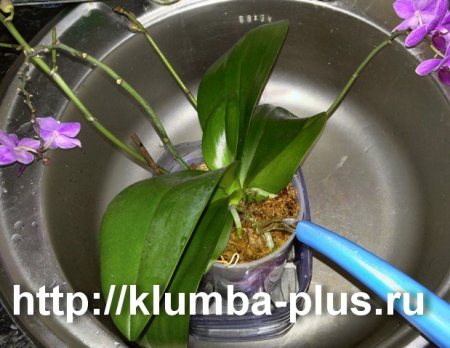

How to water phalaenopsis?
Having answered the important questions when to water the phalaenopsis and with what water, it remains to learn how to properly water this orchid. The watering method is very important for this exotic houseplant with beautiful flowers.
At home, phalaenopsis orchids grown in a well-breathable substrate consisting of pieces of pine bark. With normal watering, water quickly passes through pieces of bark and flows down through the drainage holes without saturating the roots of the plant with water, so the phalaenopsis should be watered by immersing the pot in water for 15-20 minutes. To do this, take a small container, slightly larger than the diameter of the pot, put a pot with an orchid in it and pour prepared water for irrigation using a watering can until the water reaches the upper level of the substrate. After standing in water, pieces of bark will be saturated with moisture, after which they will gradually give it to the roots. After the time has elapsed, the pot is removed from the container with water and left in the sink or in the bathtub until all the water is poured out of the pot through the drainage holes, after which the flower is returned to its original place.The procedure for watering the phalaenopsis orchid takes 15-20 minutes, but since the flower is watered once or twice a week, it does not cause trouble for the owners.
How to care for an orchid
In its natural environment, the orchid grows on trees, and its roots are exposed to the sun, air and water. To successfully grow this capricious flower at home, you need to follow the basic rules of caring for it.
Did you know? The author of the modern theory of evolution, Charles Darwin, devoted a separate scientific work to the methods of pollination of orchids. The work captures many details about the plants that admired him.
We offer a short memo for those who are just going to cultivate this amazing plant:
- Provide the flower with bright light, but try to keep it out of the direct afternoon sun.
- Orchids are much more tolerant of drying out than water oversaturation, so arrange for occasional short periods of drying out.
- Maintain the temperature in the room within + 10 ... + 30 ° С.
- Provide high humidity in the apartment. The flowering plant prefers humid air, similar to the atmosphere of the tropics. To do this, you can, for example, keep the pot in a pebble tray filled with water.
- Orchids love a lot of fresh air, both around the roots and leaves. Create conditions for air movement around the roots. Make sure the container has drain holes. The proper irrigation regime will be violated if there are no holes in the container through which water can flow freely.
- Use containers specially designed for growing orchids. They are usually made from terracotta clay. You can also grow the presented plant in a glass pot, the main thing is that the container has additional drain holes at the bottom or on the sides.
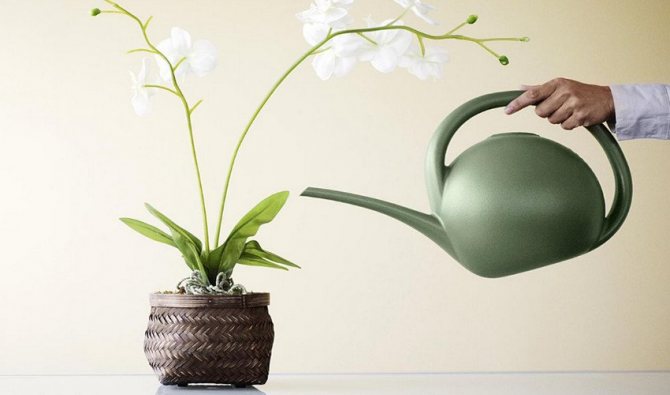

Step-by-step instructions for beginner florists
Undoubtedly, the bowl plays a big role in the growth and development of any plant, and orchids in particular. All growers prefer different types of bowls: clay, glass, plastic, with and without drainage holes.
And of course, depending on the pot, the watering of the plant will also be different. Consider separately each type of bowl and the correct care in it.
Planter without drain hole
Irrigation of an orchid in such a pots has its own characteristics. Watering should be carried out only on top of the ground, it just makes no sense to immerse it in a vessel with liquid, because there are no holes for draining the water.
It is allowed to water the orchid in the shower using a watering can, in this case, after it will be necessary to drain the excess liquid. This is done quite simply: you need to turn the flower pot over, holding the root system and pour out the water.
You need to irrigate an orchid in a pot without holes less often, because the soil in such a planter will remain moist for a much longer time. The recommended interval between waterings is 14 days. You can adjust this frequency based on the condition of the ground.
Transparent and opaque for growing
Orchids planted in clear pots with a drainage hole can be watered in several ways. You can use hot showers, immersion in water, or watering. Each method has its own nuances.
If the pot is immersed in water, you need to lower the bowl slowly so that the roots do not push the flower out. It is necessary to keep the plant in liquid for about 30 seconds and the same amount in the air.
This method of irrigation is considered the most efficient and less costly. Thus, you need to water the plant every three days, and in colder times - once a week.
Watering with a watering can is carried out carefully, without touching the flowers of the plant and the axils of the leaves. You need to water until water flows out of the hole. Drain excess water from the pan.
The advantage of transparent pots is that the owner can clearly follow the watering intervals.If there is an accumulation of condensate, small drops of liquid on the wall of the pots, then it is too early to water the plant.
The methods for watering a flower in an opaque pot are not very different from the previous one. Their only drawback is that you cannot see the condition of the roots for the next irrigation.
However, there is one proven method: you need to take a wooden skewer, deepen it to the very end into the ground and leave it for half an hour. If the stick remains dry after the expiration date, then it's time to water the orchid.
Below you can see a photo - how to properly water orchids at home for beginners:
Read also: How to care for orchids at home after buying in a pot: step-by-step instructions on what to do with them, when they brought them from the store, a photo of a flower
Potential consequences of improper care
Orchids react sharply to mistakes in caring for them. This reaction does not appear immediately. But when the consequences of improper care become visible, the plant, as a rule, cannot be saved. Here are the manifestations of the most common mistakes in orchid keeping:
- Leaves lose turgor... The reason is the dehydration of the plant due to insufficient watering, low air humidity or damage to the root system;
- Swelling on the leaves - edema of leaf tissues due to excessive watering. Watering should be reduced, watering only after the substrate has dried;
- Rotting of the top leaf or growing point - a fungal disease, the cause of the development of which is the ingress of water into the core of the plant. If the rot has not yet affected the growth point, the indoor flower can be saved by removing the rotten fabric and drying the core;
- Yellowing of orchid leaves - a natural process, if only the lowest leaf turns yellow and dies off. But if the process is massive, the reason for this is most likely damage to the roots or their decay. In some cases, yellowing of the leaves can occur from a lack of iron or potassium;
- Indented areas of flower leaves indicate prolonged contact of the leaf blade with water. This can happen after a lot of water gets on the leaves when watering or spraying. It is also possible with watering by immersion, if the leaves are dipped into the water;
- When direct sun hits the leaves of the plant sunburn occurs. They can be of various types. Most often, there are dry spots with a dark rim, but there are burns in the form of black spots with a yellow rim or just light areas of an indefinite shape.
Other methods
Some growers add a 3% hydrogen peroxide solution to the water for irrigation to saturate the plant with oxygen. However, orchids do not use oxygen for growth, but release it. To carry out the processes of photosynthesis, the plant is able to provide itself with oxygen. Hydrogen peroxide can be used to spray the upper part of the flower, as peroxide has an antiseptic effect and reduces the load on the plant's immune system, as a result of which the orchid can channel energy towards growth and development, rather than protecting against pathogens. The spray solution is prepared in a proportion of 2 teaspoons of 3% hydrogen peroxide per 1 liter of water.
With improper care and excessive moisture, orchids can develop root problems. In this case, the flower requires immediate transplantation, removing the affected roots and replacing the substrate. To prevent the development of the disease, it is recommended to soak the roots in a weak solution of potassium permanganate before transplanting into new soil. For 1 liter of water, you need to take 3 - 4 crystals of manganese so that the solution turns out to be pale pink. A high concentration of permanganate can burn the roots and the plant will die. Watering with potassium permanganate can be done no more than once every 2 - 3 months, so as not to dry out the roots.The procedure is carried out for the prevention of infectious diseases and protection against parasitic insects.
Epin helps to speed up rooting after transplanting, stimulates the immune system of the plant and increases resistance to diseases, which is why it is often used to treat orchids. It is not recommended to water with "Epin", since orchids do not grow in the soil, but in a substrate that neutralizes the effect of the drug. The product is used to spray the top of the flower. The solution is prepared in a proportion of 0.2 ml of "Epin" per 1 liter of water. You can soak the roots in the solution for 5 to 10 minutes before transplanting.
Yeast feeding promotes the activation of growth, strengthens the immune system of the plant, increases resistance to diseases, and also prolongs the duration of flowering and increases the number of flowers. To prepare a solution for irrigation, you need to dilute 1 g of yeast in 1 liter of warm water. After complete dissolution, dilute the resulting liquid with 5 liters of water. Watering should be done on top of the substrate, under the root, avoiding contact with the vegetative organs of the plant. Feeding with yeast is recommended 3-4 times per season.
Watering orchids with garlic water prevents the development of fungal diseases, increases resistance to infections and viruses, helps fight pests and strengthens the plant's immune system. Garlic dressing is desirable after flowering. To prepare a garlic infusion, you need to peel and chop 150 g of garlic. The resulting mass is diluted with two liters of warm water, covered with a warm lid and insisted for 5 days in a dark place. The prepared solution is used for watering from above on the substrate and for spraying the orchid after flowering.
The principles of proper irrigation
Often, those who grow an orchid at home are sure that it needs abundant watering and irrigation. Although this plant is native to the tropics, excessive moisture is detrimental to it. The frequency and method of watering, the stage of plant development and the quality of the water matter.
What water to water an orchid
The water temperature should not be lower than + 18 ° С, the optimal one is + 30… 35 ° С. Plain tap water contains impurities harmful to domestic plants: residual chlorine and mineral salts. To make it suitable for watering orchids, it is defended for 3-4 days.
For additional softening, tap water can be mixed with distilled water in a ratio of 1: 2 or 1: 1 if tap water is of medium hardness. Pure distillate is not suitable for irrigation.
Better yet, use softened, boiled, rainwater, purified, or melt water.
But rainwater is suitable for irrigation only if it was collected outside the metropolis, because, passing through the air, it adsorbs poisonous gases, heavy metals and other harmful substances. Rainwater collected outside the city is stored in a cool, dark place (cellar, refrigerator) so that microorganisms do not develop in it.
Boiling will soften your tap water. This is the easiest and most affordable way to prepare water for irrigation.
If an additional fine filter is installed in the house, which frees tap water from microorganisms, salts, chlorine and other impurities, it does not need to be boiled or defended before use.
Additives
To improve the quality of water, substances such as garlic juice, potassium permanganate, and succinic acid are added to it.
- Watering orchids with garlic water is carried out to stimulate flowering. In addition, garlic, due to its antiseptic properties, disinfects the soil. To prepare the product, 6 medium cloves of garlic are squeezed out in 0.5 liters of settled water, the container is tightly closed and left to infuse for a day. The finished infusion is filtered and bred in a bucket of warm, settled water, into which the flower will submerge. The infusion can be applied 2-3 times a month, except for periods of rest and flowering.A new peduncle should appear 2 weeks after stimulation.
- Watering orchids with succinic acid is carried out in order to accelerate the rooting of shoots, stimulate flowering, increase the resistance and adaptogenicity of the plant to changes in environmental conditions. A solution of succinic acid is used to resuscitate plants affected by temperature changes or in other stressful situations. It is best to use the product during periods of intense growth (spring and summer), but not in winter, when the plant is dormant.
- Succinic acid can also be added to the garlic solution. To prepare the product, the easiest way is to buy succinic acid in tablets at the pharmacy. In 1 liter of hot water, dilute 1 tablet of acid. The finished solution can be stored for no more than 3 days. Use it like a garlic solution.
- The roots are washed with a weakly pink solution of potassium permanganate during transplantation or during a plant disease for disinfection. The remedy is in some way a source of potassium.
It is important to enrich the water with oxygen before watering. To do this, it is poured from container to container.
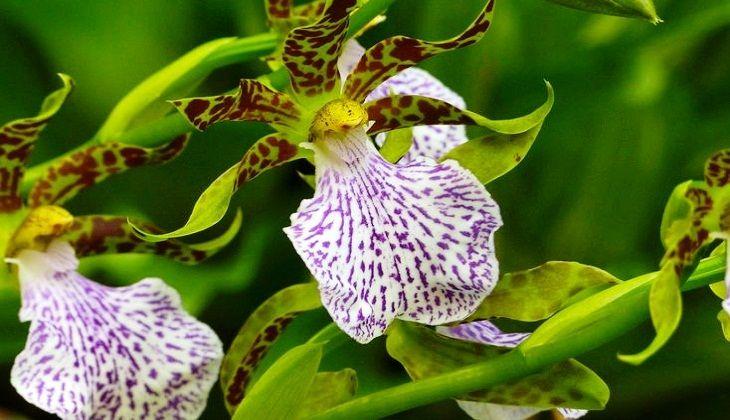

How often to water
It is impossible to determine exactly how many times a week orchids should be watered. Watering this plant strictly according to the calendar is fundamentally wrong. The frequency with which to water orchids is influenced by the state of the plant, the stage of its development and the state of the substrate and roots for a given period of time.
The flower cannot be constantly in high humidity conditions. This leads to decay of the roots and the appearance of other diseases. To determine when it is time to water your orchid, you need to take into account the following signs:
- The substrate is dry. The easiest way to assess its condition is in a transparent pot. If there are no condensation drops on its walls, and the substrate is light in color, the plant can be watered. To moisten the bark particles, which are often used as filler for orchids, it is best to immerse the flower pot in a container with settled or boiled water.
- The roots became light and took on a silvery hue. Well-moistened roots are bright green. As they dry, they brighten. When all the roots are silvery, the flower can be watered.
- If the pot is opaque, its weight can be taken into account. After drying, the pot with the substrate becomes much lighter. You can make sure that the flower needs moisture by sticking a wooden stick into the pot. If it stays dry, it's time to water the plant.
Correct watering of the phalaenopsis orchid also depends on the condition of the plant. At rest, it rarely needs hydration - once every 2-3 weeks, during the period of active growth of green mass and flowering - more often, 1-2 times a week. In the hot season, the flower is watered more often, since the substrate dries out faster.
After shopping in the store
First of all, after buying, you need to make sure that there are enough drainage holes in the pot. If they are not, they can be done with a hot nail. For the first time, the flower is watered only 7-10 days after settling in a new place.
Since the phalaenopsis orchid tolerates drying out more easily than waterlogging, such exposure allows both the substrate and the roots of the plant to dry well. At the same time, the air humidity in the room should be within 75%.
In the store, flowers are watered with water softened and disinfected with special means, so a simple tap orchid can react negatively.


During flowering
Irrigation of orchids at home during flowering should be done more often. Despite the fact that the condition of the roots and substrate still matters, the plant will have to be watered 2-3 times a week, as it prefers moist soil during this period.
In summer, in a room with a humidity of 75-80% and a sufficient amount of light, you need to water the phalaenopsis orchid every 5-7 days, in winter, when there is not enough light, every 7-12 days.
At the same time, over-watering can lead to the death of the buds. Therefore, despite the increase in the frequency of watering, you should not use the immersion method every time. If the substrate is still wet, just moisten it a little on top. Potassium-phosphorus fertilizer can be added to the water for irrigation once a week.
In winter
In winter, like most indoor plants, orchids enter a dormant state. The metabolic processes in the cells slow down, the needs are reduced, so watering the flower more often than 1 time in 2 weeks is not required.
It should be understood: the orchid needs to be watered if it needs water. How to do it in winter - here they use the same methods as described above. But due to the fact that the roots of the plant absorb moisture more slowly in winter, it is better to use the immersion method during this period. It is important to let the water drain well from the roots before returning the flower to the windowsill. In winter, it is always colder in this place, so the plant should be protected from temperature shock due to temperature differences.
Watering the plant with a shower in winter is best in the evening. The flower should be left in the bathroom overnight to allow the water to drain well. This will help prevent rotting and mold growth in the pot.
In the spring, the plant wakes up, the metabolism in the cells accelerates, and the need for moisture increases. Therefore, with the onset of heat, watering is increased.
After transplant
In the process of transplanting, the roots of the plant are washed in a light solution of potassium permanganate. Since this entire process is stressful for the plant, it will need several days of rest. Watering the orchid abundantly immediately after transplanting is not worth it. It is enough to put the pot in water for 20-30 minutes.
It is best to postpone the first full watering for 14 days. If the substrate is too dry, it is enough to irrigate it with a spray bottle. The first watering after transplanting is best done with a pallet or individual planter.
Orchid feeding after transplanting is carried out during the first moistening of the soil; fertilization can be repeated only after 21 days.
Photo
Below is a photo of watering flowers growing in pots:
Fundamental rules
To begin with, it is necessary to water the orchid through the top of the pot, allowing the excess liquid to drain.
It is impossible to give precise recommendations for watering orchids for any occasion in life. However, there are a few general rules that should be followed:


Watering should be done infrequently, but abundantly.- The water temperature should be room temperature, or slightly higher.
- The best time of day for irrigation is morning.
- During watering and spraying, you need to make sure that water does not get on the flowers of the plant, otherwise spots will form on the petals and the orchid will wither faster.
- Root contact with water should not exceed half an hour.
- The liquid after watering should all drain from the pot.
What should i avoid?
- To avoid excessive waterlogging of the flower, you can build a drainage of foam or expanded clay with a layer of four centimeters.


Spraying must be carried out at a distance of twenty centimeters, so that the liquid evaporates faster from the surface.- For orchids of the Phalaenopsis and Wanda varieties, when watering, it is necessary to avoid the ingress of water on the core, which will begin to rot from excessive moisture. During irrigation with a shower, this cannot be prevented, therefore, after the procedure, the core is thoroughly wiped with a dry cloth.
- If a grower waters an orchid using the immersion method, he should pour new water after each pot. This precaution is necessary in order to prevent the transmission of diseases from one plant to another.
Water and solutions for watering orchids
You can water a room orchid not only with ordinary water, but also with various solutions and infusions that will help improve the health of the culture and make its flowering more abundant and lasting.
Note: Most often, succinic acid is used for watering.It helps the leaves to stay firm and helps the plant to better tolerate changes in humidity and high temperatures.
There are other recipes for watering an orchid with various infusions and preparations:
- The garlic solution helps to saturate the substrate with nutrients and vitamins. However, it should be remembered that it is not worth adding this substance to the soil too often, since the orchid will start to hurt from an excess of nutrients.
- An indoor flower can also be watered with hydrogen peroxide, ammonia and potassium permanganate. All these drugs serve as an excellent prevention of the spread of pests and diseases. For this, a solution is prepared with a minimum concentration of manganese or another substance, and watering itself with these preparations is carried out no more than once a week. If the solution is too concentrated or frequent application, the plant can quickly die.
- For a similar purpose, watering with iodine or yeast is used. As in the previous case, only a weak solution should be used.
Remember that any watering agent should be weak. Orchid roots are not in the soil, but on the surface of the substrate, and a high concentration solution can cause severe burns or nutrient overload (Figure 4).


Figure 4. For irrigation, you can use not only ordinary water, but also solutions of conventional preparations
As a result, you will achieve the absolutely opposite effect: from such watering the orchid will first start to hurt, and then it may even die.
When watering is reduced
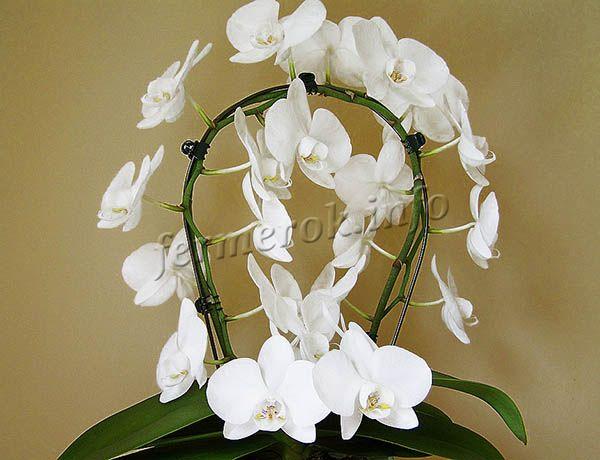

Phalaenopsis orchid, for example, is made to bloom in winter by a sharp reduction in watering
Reduced watering is necessary for those types of orchids that need a dormant period (oncidium, dendrobium, cattleya). For them, watering begins to be reduced from October. Since December, this procedure is carried out no more than 1 time per month. But since March, watering has been resumed with the same frequency.
Important!
It is not difficult to understand that the plant is in a dormant period. An actively growing orchid has green roots saturated with water. If the plant leaves during the dormant period, its aerial roots become white, tightened with velamen.
In order for orchids to bloom at home, watering is usually reduced. The Phalaenopsis orchid, for example, is forced to bloom in winter with a sharp reduction in watering (once every 15 days). To do this, you also need to rearrange the flower in a darkened place with a temperature of up to + 16 ° C. In this case, the flower begins to bloom and gives buds until summer.
What does it depend on?
Various factors determine how often you water your orchids:
- season;
- plant life cycle;
- temperature and humidity level;
- lighting;
- soil features;
- growing method.
Attention! The less light, temperature and the shallower the substrate, the less often you need to water.
Hanging orchids require frequent spraying 1-3 times a day. Plants planted on a block are watered more frequently than potted plants.
In addition, the rate of absorption and assimilation of moisture in different varieties is not the same. Wet soil is loved by:
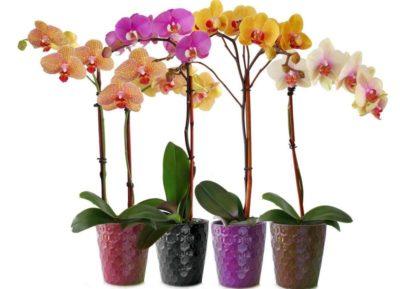

phalaenopsis;- cymbidium;
- papiopedilum;
- miltonia.
They prefer to remain without watering until the substrate is completely dry:
- cattleya;
- oncidium;
- dendrobium;
- odontoglossum.
Individual approach
To determine the exact timing of watering, you need to focus on the type of plant. Phalaenopsis should be watered by immersion for half an hour. It can also be filled with copious amounts of water. It is advisable to spray the surface of the substrate periodically. In summer, watering is carried out every 2-3 days. In winter it is enough 2 times a month. It is advisable to place these plants in a transparent container to determine the condition of the roots. Make sure that the liquid does not get into the growing point, as this phenomenon can cause the death of the plant.
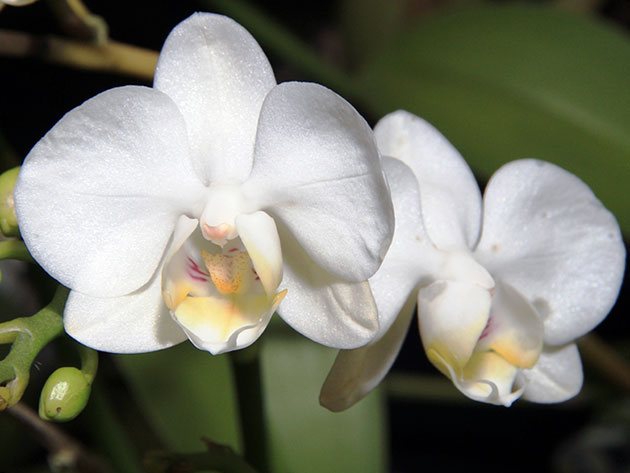

White Phalaenopsis
Wanda grows well if it is located in a room with high air humidity.It is advisable to practice daily spraying, often applying water under the roots. Once every few weeks, you can soak the roots by leaving the pot in the water for 1-2 hours. Carry out the procedure carefully, do not allow liquid to penetrate the leaves, peduncles. Do not let the inflorescences get wet.


Orchid Wanda
Cymbidium and Cambria are characterized by the need for moderate watering. In summer, it is advisable to spray them daily, but in winter the number of waterings is reduced to 2 times a week. If you do not have enough time to leave, you can fill the flower with 1 liter of water 2-3 times a month. In order to maintain high soil moisture for a long time, you can mulch with moss.


Cymbidium Orchid
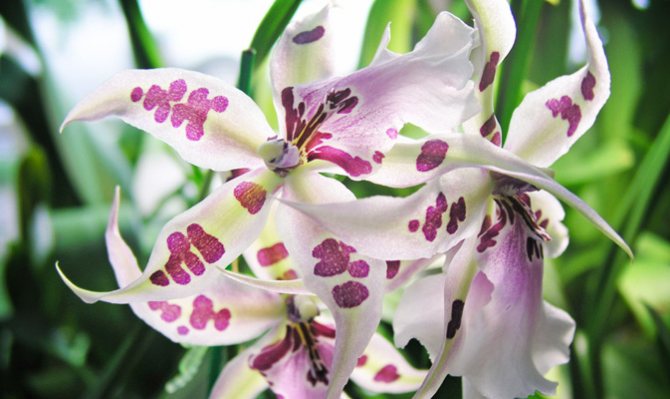

Orchid cumbria
For Cattleya, an individual irrigation regime is being developed; it is necessary to moisten the ground after complete drying. It is undesirable for Miltonia to spray. Moderate watering is practiced, the soil surface is irrigated. In spring and summer, it is necessary to water the plants 3 times, in winter - less often, focusing on the state of the root system.
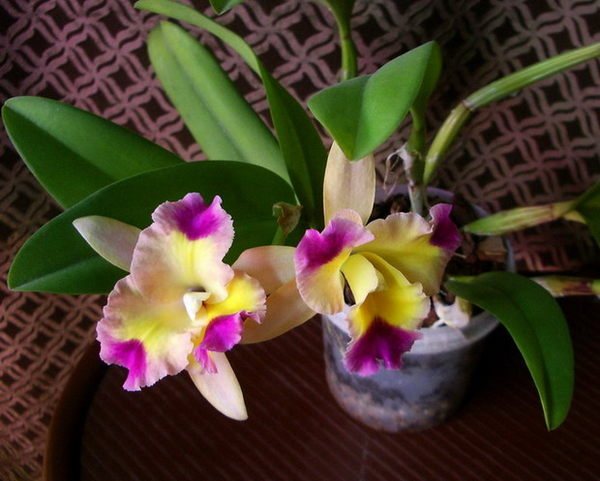

Cattleya Orchid


Orchid Miltonia (Miltonia)
In order for watering to contribute to the active growth of the orchid, not to cause unpleasant phenomena, it is necessary to make a lot of efforts. The process of watering an orchid requires attention, however, if this action is performed correctly, you can get rid of many problems, plant diseases. When the plantings receive a sufficient amount of moisture, increased flowering occurs, the shade of the leaves becomes brighter, and the life of the plants increases.
Spraying orchids
We recommend reading our other articles
- Dutch radish varieties
- Zucchini Cavili F1 - variety description, cultivation and care
- Description of cucumber variety Adam F1
- Strawberry Clery
Spraying for orchids is beneficial if done infrequently. During spraying, the spray gun is directed at the plant at a distance of 20-25 cm. For the procedure, settled or boiled, warm water is used. Of course, there are practically no nutrients in boiled water, which is important to consider.
Important!
Spraying can lead to leaf burns if the plant is exposed to the sun! And in winter, this procedure provokes the development of diseases.
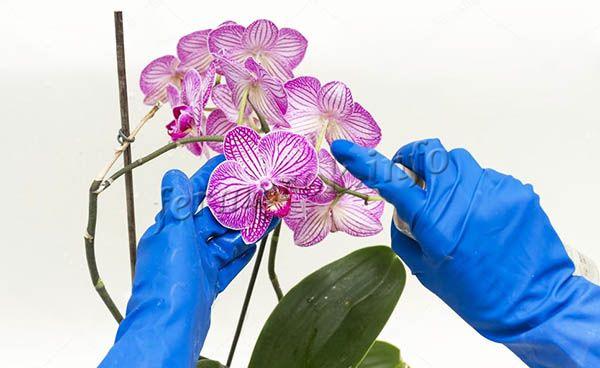

Spraying for orchids is useful if it is not done often.
Spraying is carried out only in the warm season, about once a day or a little less often. The procedure is done early in the morning. It is advisable that the spray bottle spray the water in small drops, not large ones. Most orchids tolerate this procedure well, but for the Miltonia species, spraying is never carried out, because the plant does not tolerate it.
How do you know when to water?
Pay attention to the color of the roots and condensation on the sides of the potif the pot is transparent. The silvery-green color of the roots, the absence of condensation and a clearly dried substrate indicate that it is time to water the plant.
If the pot is opaque, pay attention to the weight of the pot. - with a dry substrate, it is lighter. For more information on watering orchids in a pot, go to this article.
What happens if you do this too often?
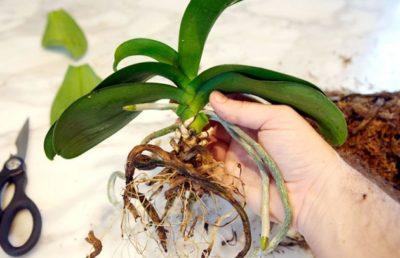

The plant is difficult to tolerate excess moisture. If you water it without waiting for the substrate to dry, it will thicken and water will stagnate. The root system can rot. Losing the ability to fully eat, the plant weakens and is capable of dying.
In this situation, urgent measures are required to save the orchid. Should:
- transplant the plant;
- cut off rotten roots;
- treat the sections with activated carbon powder.
We talked about how to water an orchid after transplanting into another pot here.
Orchid subrust so that it blooms
There are the following stimulants for the orchid to bloom. The Epin growth stimulator is very popular among flower growers. This drug is sprayed on the orchid every morning, adhering to a certain time.
Another solution that stimulates growth and antistress for orchids is succinic acid. 2 g of this acid is dissolved in 1-2 l of water. The solution is sprayed completely on the orchid. The solution with succinic acid must be consumed within 3 days.
It is strictly forbidden to treat the orchid with growth stimulants after transplantation; the flower needs some time to take root well. Remember to fertilize in moderation, according to the instructions.
Watering orchids under different circumstances
Under different circumstances, an orchid is watered, taking into account its biological characteristics. Only then will the plant develop correctly, bloom in time and profusely. Watering is carried out taking into account the growing season. When the orchid grows overgrown with new leaves and throws out the arrows, more moisture is required. However, the flower needs rest, therefore, during the cold weather, watering is reduced.
How to water orchids in winter
With the arrival of cold weather, epiphytic plants are given a dormant period that they need. Winter orchid care is slightly different from summer. In the wild, after flowering, epiphytes form seeds that are blown away by the wind. This is possible if there is no rain. Therefore, indoor orchids need to create similar conditions. From mid-autumn and throughout the winter, they are watered much less frequently. The optimal frequency is once every 2 weeks. It is not necessary to adhere strictly to such breaks, but the soil should not dry out too much.
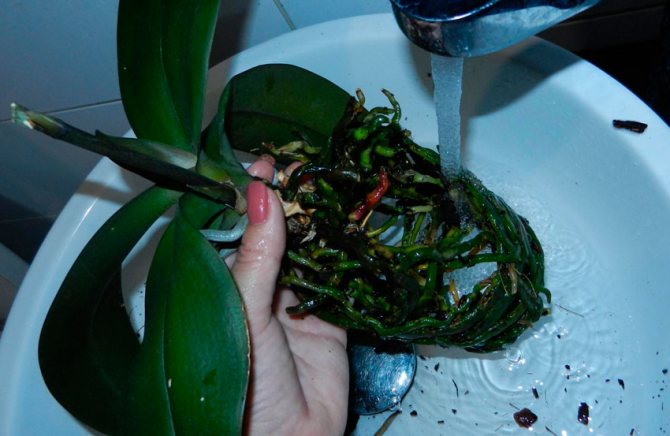

Before returning the flower to its place, you need to let the water drain. Otherwise, the roots can rot, because in winter, it is cold by the window, which will cause the soil to dry for a long time. A warm shower is best done in the evening, and leave the plant in the bathroom until morning. So that after flowering the orchid quickly regains lost strength, fertilizer is added to the irrigation water. In autumn and spring, orchids should be fed once a week, and in summer and winter - once a month.
Watering a flowering plant
When plants are in bloom, they need more moisture. Orchids need to be watered frequently, as soon as the substrate dries up a little. It is not necessary to wait for the condensation drops to evaporate. Blooming orchids do not need complete drying of the soil. Usually watering is carried out every 3-4 days, trying to moisturize the substrate abundantly. Do not splash water on the buds. An orchid that has thrown out the arrow is watered from a watering can. The plant is responsive to immersion in water.
Important!
If the flowers begin to fade, and the colored area at the ends of the roots has decreased, the frequency of watering should be halved so that the soil has time to dry out. In order to prevent the development of a fungal infection, the orchid can be watered with a weak solution of potassium permanganate.
Watering a flower after purchase
Orchids that are sold at exhibitions or flower shops can be planted in a specific soil. In addition to traditional moss and bark, the substrate may contain various additives that maintain the presentation of the plant. Moisture accumulators called "sponges", "sponges" or "washcloths" can be added to the soil. They are pieces of synthetic material that can absorb large amounts of liquid. Thanks to such components, the flower can not be watered for a long time, which is important during long-term transportation or storage.


The synthetic absorbent material is harmless to plants and does not rot. The danger lies in the inability to determine the amount of moisture in such a "storage". If the seller does not warn about its presence in the soil, the flower may die due to waterlogging. Therefore, the orchid needs to be transplanted into fresh soil. However, there is no need to disturb her during flowering.
At home, the purchased orchid is kept in quarantine for 2 weeks in order to detect pests and destroy them in time. During the first week, it is not watered. Then the substrate is moistened occasionally. The first time to saturate the roots, you can use the immersion method. The procedure is repeated several times to wash out unnecessary salts from the soil.Together with them, fertilizers, which are abused by manufacturers or sellers, will also go away. Most often they use strong stimulants that drain the plant. Better to get a fertilizer specially formulated for orchids.
Watering the transplanted orchid
Usually, transplanting into new soil is carried out in the spring, while the orchid has not bloomed. Epiphytes do not need a large pot, since the root system in them does not develop well. After transplanting, the flower must be watered abundantly so that the new substrate absorbs more moisture. Then the pot is immersed in warm, boiled water for 10-20 minutes. The more massive the root system, the longer the orchid is kept in water when watering.
After the procedure, the flower pot is removed from the container and the water is allowed to drain. At first, the plant is placed in a shaded place. The next watering is carried out after about 2 weeks. The established plant requires watering and feeding, which make up for the lack of micro- and macroelements. The transplanted orchid needs to be watered 2-3 times every 7-10 days.
On a note!
If the pot floats up during the immersion, you can put small stones around its edges.
When is there not enough moisture?
Orchids tolerate short periods of drought quite easily. These plants store a sufficient amount of moisture in the roots and leaves. However, rare watering can cause the root system to dry out. If there is not enough water, the orchid stops growing and does not bloom.
On a flowering plant experiencing an acute moisture deficit, flowers and unblown buds dry out prematurely.
Proper watering is an important part of caring for indoor and garden orchids. How and how many times a week a flower should be watered is determined by the time of year, life cycle, keeping conditions and variety. Improper soil moisture can lead to growth problems and even plant death. If you water an orchid taking into account all factors, it will thrive and bloom luxuriantly.
Drainage
A drainage layer is only necessary if a heavy substrate is used. If only the bark is used, no drainage is needed. Expanded clay, pebbles or the same pine bark of a large fraction are suitable as drainage. Read more about drainage for orchids in this article.
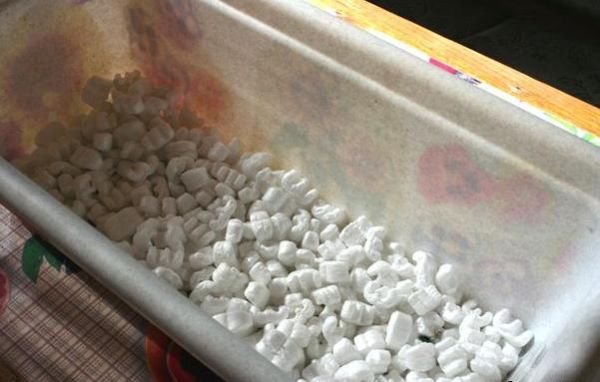

How not to water the plant?
To prevent the consequences of improper watering, you need to know how to moisturize an orchid:
- You can not pour water on the leaves, since the prolonged presence of the liquid on the platinum leaf will make the flowers faded and lethargic.
- Do not use too cold and hard water for irrigation. This will lead to the formation of yellow leaves, accelerated death of areas of the root system.
- When using the immersion method, do not use the same water for all plants. Otherwise, the presence of a certain disease in a particular flower can cause massive destruction.
Description
Orchids are amazing indoor flowers that come to us from the southern tropical forests. The appearance attracts attention not only by the unusual shapes and colors of the flowers, but also by the unique structure of the root system, which distinguishes orchids from other plants. The species diversity includes more than 25 thousand species. Breeders are constantly replenishing the abundance of orchid varieties and breeding new ones that are most adapted for life at home. Modern hybrids are unpretentious to care for and multiply easily. However, you need to know how to water them properly.
A distinctive feature of orchids is the mirror symmetry of the flowers. In shape, the flowers resemble a soaring butterfly and reach a size from 1 to 15 cm in diameter. Depending on the variety, orchids have a variety of colors: from snow-white to deep blue and purple hues. The root system participates in the process of photosynthesis and provides the plant with adequate nutrition.Powerful, thick roots help the flower to gain a foothold on any surface, therefore, in their natural environment, orchids live on the trunks and branches of trees, as well as on stones and mountain slopes. At home, the plant is grown in a special substrate, because the land is unsuitable for the life and growth of orchids.
Watering during flowering
Proper watering is essential during the flowering period of the orchid. It takes a lot of energy for the plant to form inflorescences, and therefore it needs proper nutrition. At this time, the frequency of watering increases to 3 to 4 times a week. However, do not overmoisten the soil. Water should be introduced as the substrate dries up, when the roots change their color from dark green to silver.
Blooming orchids need to be sprayed to maintain adequate moisture levels. The procedure is carried out only when the air in the room is too dry. Moisture should only get on the leaves of the plant, the buds do not need to be irrigated.
Excessive watering during the flowering period can lead to shedding of flowers. The orchid can easily withstand short periods of drought. Therefore, you should not over-introduce water or water the plant in advance if it will not be possible to water in the coming days.
It is better to water a blooming orchid more often, but with less water. This will help extend the flowering period.
succinic acid
Watering with succinic acid helps to prolong flowering. Powder or tablets can be purchased at a pharmacy. The substance helps to accelerate tissue regeneration, increases plant resistance to diseases and saturates the leaves with chlorophyll. This is necessary for the normal flow of budding and flowering processes.
The solution is prepared in the proportion of 1 tablet to 1 liter of water. The drug is dissolved in 200 ml of liquid, and then the missing amount of water is added. The powder is diluted at the rate of 1 g per 1 liter. If it is not possible to weigh the substance, the powder is added to the solution at the tip of a knife.
It is better to use the prepared mixture right away. The maximum shelf life of the resulting liquid is 2 - 3 days, after the expiration of the term, succinic acid loses its useful properties.
It is necessary to water the plant from a watering can with a small stream over the substrate. The liquid must be injected slowly so that it is evenly distributed and absorbed. The manipulation is carried out until the excess begins to flow from the drainage holes. After all excess moisture has drained, it must be drained from the pallet.
If during the day there is a temperature difference in the room, it is better to perform the procedure in the morning. The solution can be applied once every 20 to 30 days.
How and what to water so that the plant blooms?
Plants are watered with water, and top dressing is done with special, balanced fertilizers. In rare cases, you can add spraying with growth stimulants or growth regulators, such as epin or zircon.
You need to understand that the flowering of an orchid depends directly only on lighting and the correct temperature regime (changes in day and night temperatures).
Proper watering is important for the health and rhythms of the plant itself, and affects flowering only indirectly. By itself, it does not play a significant role, no matter what you water. For more information on how to water an orchid to stimulate flowering, read here.
To make the orchid turn blue
Manufacturers own technology colored orchids are kept secret. Therefore, if you do not go to ruin your plant by watering it with blue, watercolor or gouache solutions, refrain from this kind of action. Well, if you still really want to know how to water the plant so that it turns blue, then read this article.
Watering in winter during flowering
With the onset of flowering in winter, the plant is watered as usual. Read more about watering in winter during flowering in this article.
Outdoor irrigation
The garden orchid loves rain and can be irrigated in the morning and evening. Watering is necessary regularly, not allowing the soil to dry out. However, waterlogging should not be allowed. The garden orchid prefers to stay in moderately moist soil. This also requires good drainage.
On a note. For an orchid growing outdoors, it is better to organize a drip system.
Consider the frequency of watering your orchids when the plant is in bloom and during dormancy:
Top dressing
There are quality fertilizers on sale specially developed for orchids (“Ideal”, “Rainbow”, etc.). Top dressing is carried out in every third watering in the spring season, in summer the application of nitrogen fertilizers is reduced. The frequency of feeding also depends on the period of the plant's life - in the dormant stage it is lower.


For feeding orchids, only special fertilizers are used.
Feed the plants for 30 minutes by immersion or tray watering by adding liquid fertilizer to the water. Orchids grown without a substrate are sprayed with a prepared solution (for 1 part of fertilizer - 6 parts of water).

